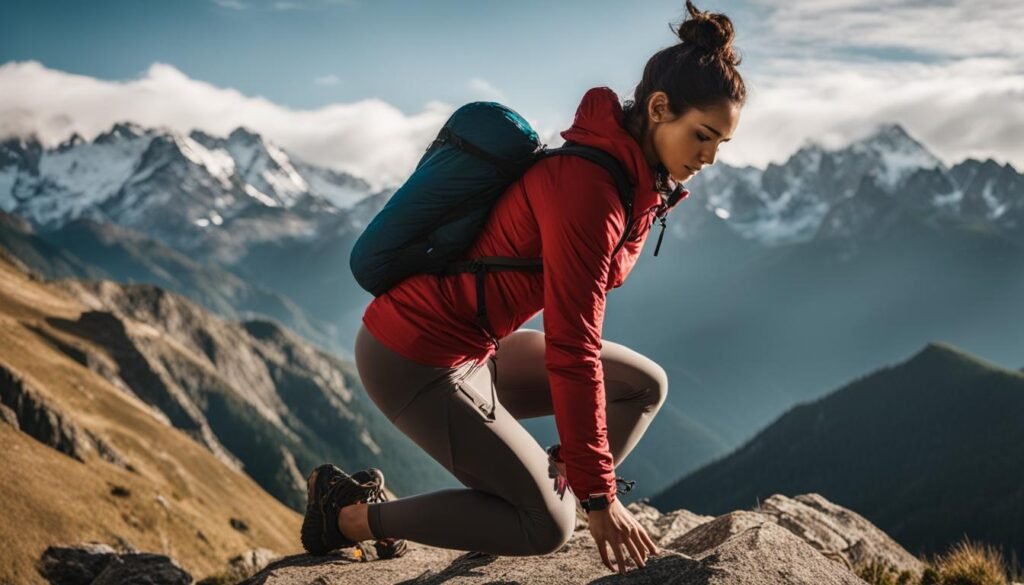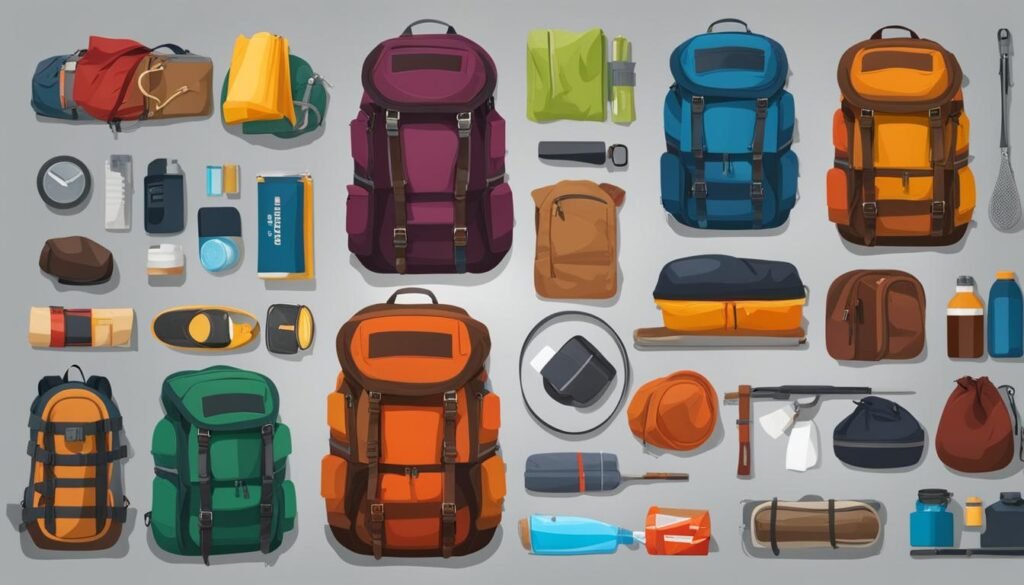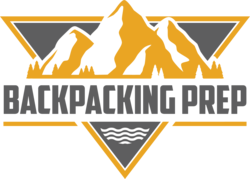Embarking on a backpacking journey has the captivating allure of adventure, and it’s a transformative experience that offers solitude, scenic grandeur, and an intimate connection with nature. For those novice explorers looking for backpacking tips for beginners, know that the trail is both forgiving and endless in its teachings. A beginner’s backpacking guide isn’t just a list of items to pack; it’s an initiation into a life-changing hobby that encourages simplicity and demands resilience.
Understanding the backpacking essentials—the nitty-gritty details from scoping out campsites and water sources to the emotional preparedness for facing the wilderness—lays the groundwork for a memorable excursion. Whether these tips are for backpacking through the majestic national parks or lesser-known trails, one needs to be armed with knowledge and the right attitude. This beginner backpacking tips guide will help you meld preparedness with an open spirit, paving the way for an odyssey filled with the splendor of sunsets and the thrilling encounters with wildlife that make backpacking such an enchanting pursuit.
Remember, every step on the path not only brings you closer to the heart of the wild but also to uncovering your own inner strengths and joys. So lace up those boots, adventurers; the trail awaits!
Choosing the Right Trail for Your First Backpacking Adventure
Starting your journey into the wilderness begins with selecting the perfect trail that aligns with your ambitions and comfort level. Ensuring that you have a rewarding experience on your initial backpacking trips for beginners means being mindful of your trail choices, the history of the area, and tapping into the wealth of digital resources available. Let’s delve into the steps that will guide you in making an informed decision for your adventure.
Pick a Destination that Resonates with You
Finding a trail that holds more than just scenic beauty, one that touches upon personal significance, can transform your hike into an adventure with profound meaning. Whether it’s a path winding through regions steeped in your heritage or landscapes woven into your earliest memories, such personal connections make each step along the way part of a larger story.
Opt for Beginner-Friendly Routes Over Rugged Terrain
As you craft your backpacking checklist, consider routes that cater to newcomers—trails that offer manageable challenges and the reassurance of accessible amenities. These beginner-friendly choices allow you to gain confidence, pace yourself, and still enjoy the striking vistas without the intimidation of advanced terrain.
Understand the Importance of an Area’s History and Significance
Immerse yourself in the background of the landscapes you will navigate. Acknowledging the indigenous history and cultural significance of a region not only enriches your experience but broadens your appreciation of the journey, instilling every observation with layers of understanding and respect.
Trail Research: Utilizing Apps and Online Resources
Embrace the digital age and arm yourself with knowledge using trail-finding tools such as Gaia GPS and AllTrails. These resources are essential in plotting your course, from discerning water sources to calculating daily distances, all tailored to fit the beginner’s need for backpacking essentials without being overwhelming.

Preparation is Key: Building Your Backpacking Fitness Base
Embarking on a backpacking adventure requires more than just an enthusiastic spirit; it’s about building the physical endurance to match the journey ahead. For beginners, it’s essential to understand that backpacking for beginners not only involves learning to pack a backpack but also conditioning the body to endure and enjoy the trails. Whether it’s the steep ascents of a mountain pass or the long miles of coastal paths, your fitness level will significantly impact your experience.

One of the most practical backpacking tips that seasoned hikers share is to incorporate regular cardiovascular and strength training into your routine months before hitting the trail. Hiking with a full pack is a unique challenge, and your body needs to be accustomed to the additional weight. This kind of conditioning is crucial not just for enjoyment but also forms part of essential backpacking safety tips—a fit hiker is a safer hiker.
In terms of nutrition, the calorie count on the trail often surprises new backpackers. The energy expenditure from hiking rugged terrain with a loaded backpack is significant, and thus the caloric intake must match. Snacking on high-calorie foods like nuts and energy bars during the hike is a practice that maintains stamina across the miles.
- Focus on exercises that build core strength and balance for better load management.
- Train with hikes that simulate your planned trail’s challenges – elevation gain, terrain types, and distance.
- Practice hikes with a weighted backpack to accustom your body to what you’ll experience.
Remember, meal planning is not just about the number of calories; it’s about the right kind of calories. The nutritional balance in your foods is vital, so be sure to include a mix of carbohydrates, proteins, and fats. The key is to find lightweight, non-perishable options that are high in nutrition and energy-dense to fuel your backpacking for beginners adventure effectively.
Opt for dehydrated meals that can easily be rehydrated on the trail, and pay attention to both the weight and caloric density of each food item. It’s not just about how much you carry, but what you carry that will keep your energy levels consistent.
Ultimately, backpacking is a blend of physical readiness and logistical planning. It is about understanding the demands of your body as well as the terrain you’ll be exploring. By dedicating time to prepare both physically and nutritionally for the journey, you can ensure a memorable and safe outdoor experience filled with incredible views and personal triumphs.
Backpacking Skills: Transferring Everyday Expertise to the Trail
For many starting their backpacking journeys, recognizing the value of urban experiences in nature’s expanse can be quite rewarding. Intuition honed in bustling cities becomes a valuable asset amidst the unpredictable elements of the wild. As we delve deeper into understanding how our daily competencies aid in wilderness adventures, we uncover the profound impact they make on both safety and enjoyment. Bearing in mind essential backpacking safety tips, let’s explore how these skills play out in the world of backpacking.

Using Your Urban Awareness in the Wild
Navigating through the hectic urban sprawl often sharpens one’s situational awareness, a skill that seamlessly transitions to staying vigilant on the trail. The ability to observe and react to one’s environment in the city correlates directly with the need for attentiveness to natural cues and potential hazards when backpacking.
Communication and Asking Questions
Clear and effective communication, imperative in our daily urban interactions, becomes a cornerstone for ensuring safety and harmony on the trail. The ability to ask pertinent questions and articulate needs is crucial, especially when coordinating with hiking buddies or seeking advice from park rangers to better understand backpacking essentials.
Teamwork and Sharing Responsibilities
The sense of team spirit fostered in community and workplace settings finds its place in backpacking groups as well. Sharing the load, whether it’s through dividing up gear from the backpacking checklist or taking turns leading the group, nurtures a cooperative atmosphere that enhances the entire experience.
The table below showcases how everyday skills translate into backpacking competencies:
| Urban Skill | Backpacking Translation | Benefit |
|---|---|---|
| Observant Street Navigation | Trail Vigilance | Anticipate and Maneuver Natural Obstacles |
| Conflict Resolution | Effective Group Dynamics | Harmonious Hiking Experience |
| Resource Management | Efficient Gear Use | Ensure All Essentials Are Utilized |
| Clear Communication | Detailed Route Planning | Avoid Misunderstandings and Stay on Course |
| Diverse Team Building | Distribute Tasks According to Strengths | Promote Bonding and Group Efficiency |
The inclusion of everyday skills—enhanced by awareness, communication, and teamwork—demonstrates their necessity on backpacking excursions. They not only contribute to the practicalities of navigating the trail but also to fostering camaraderie and safety, which are indispensable elements of any successful outdoor adventure.
Navigating Nutrition: High-Calorie Foods for Fuel
Embarking on a backpacking journey puts your body to the test, not just physically but nutritionally as well. To meet this challenge, backpacking meals must be carefully selected for their caloric density and nutritional value. Gourmet trails cuisine can sometimes take a backseat to practical, high-calorie backpacking foods that promise to deliver the burst of energy required to tackle strenuous hikes.
Conveniently, the best backpacking tips for meal preparation hinge on simplicity: choose foods that provide maximum calories with minimum weight. This approach ensures you’re carrying only what you need, avoiding unnecessary strain from a backpack loaded with heavy provisions.
Dehydrated foods have revolutionized backpacking meals, providing an ideal balance between nutrition and portability. These meals are not only lightweight but also take up less space, an essential consideration when packing. Let’s take a closer look at some of the best options for calorie-dense foods that can keep you going without weighing you down.
| Food Item | Calories Per Ounce | Benefits |
|---|---|---|
| Nuts and Seeds | 160-170 | Rich in protein and healthy fats |
| Olive Oil | 240 | High calorie, can be added to meals |
| Peanut Butter | 165 | Energy-dense and satiating |
| Dark Chocolate | 150-170 | Quick energy boost, mood elevator |
| Dehydrated Meals | Varies | Convenient, full meals that are lightweight |
To maintain steady energy levels throughout the day, it’s also advisable to snack periodically. Try to consume a mix of carbohydrates, proteins, and fats every 60 to 90 minutes to support sustained energy release. This strategic snacking can both ward off hunger pangs and help you avoid the dreaded energy crashes that can impede your progress.
In conclusion, your backpacking experience can be greatly enhanced by applying a mindful approach to your meal prep. Incorporate high-calorie snacks and meals into your pack, and you’ll have more time and energy to absorb the magnificent views and experiences that nature provides. Remember, the right fuel is pivotal for the trail ahead.
Backpacking Tips for Beginners: Packing Your Backpack Efficiently
Mastering the art of packing backpacking gear is more than a convenience—it’s crucial for a safe and enjoyable adventure. For beginner backpacking tips, understanding what to bring and how to pack it efficiently can play a vital role in your overall experience. Here’s a guide to help you prepare your backpack like a seasoned trekker, ensuring you can journey with ease and confidence.

First, consider the distribution of weight. Heavier items should be packed closer to your back and centered between your shoulder blades for balance and to reduce strain. This typically includes your water supply, stove, and food stash. Meanwhile, lighter items like your sleeping bag can be placed at the bottom, and frequently accessed items should be easily reachable in the top compartments or external pockets.
Striking a balance between preparedness and overpacking requires a thoughtful approach. Choose versatile items that serve multiple functions to save space. A spork, for instance, eliminates the need for separate forks and spoons. Clothes should be functional, layerable, and appropriate for the climate you’ll be visiting. Furthermore, investing in multi-use technology, like a headlamp with different light settings, can make all the difference.
A great tip to maximize space and organization is to use compression sacks or zip-top bags. They not only compartmentalize your gear but also protect it from the elements. It’s imperative to ensure that all your gear is waterproofed, especially in variable weather conditions.
| Gear Category | Essentials | Tips |
|---|---|---|
| Clothing | Moisture-wicking layers, insulation, waterproof shell | Opt for synthetic fabrics that are light and fast-drying. Pack spare socks to keep feet dry. |
| Shelter | Tent, sleeping bag, sleeping pad | Consider the season and temperatures you’ll encounter. Down sleeping bags are warm and compressible. |
| Cooking | Stove, fuel, cookware | Carry a small, efficient stove and share cookware with your group when possible. |
| Food | Calorie-dense meals, snacks | Prepare servings ahead of time, and lean towards dehydrated meals that just need water. |
| Hydration | Water bottles, water treatment | Know your water sources ahead of time and bring lightweight treatment options like tablets or a filter. |
| Navigation | Map, compass, GPS device | Ensure you know how to use these tools before you hit the trail. Backup batteries for your GPS are essential. |
| Emergency | First aid kit, whistle, fire starter | Personalize your first aid kit to your needs, and know how to use everything in it. |
| Extras | Camera, journal, binoculars | Assess the necessity of these items. Many phones have great cameras, eliminating the need for extra equipment. |
Finally, always do a trial pack before your trip. Adjust the fit of your backpack and take a short walk to ensure comfort and manageability. Keep refining your gear list with every trip—experience is the best teacher for perfecting your packing process.
Pro Tip: Aim for your packed backpack to weigh no more than 20% of your body weight. For most, this will be within the range of 20-35 pounds, which is ideal for beginners to maintain stamina and enjoy the hike.
Safety Protocols: Being Prepared for Emergencies
Backpacking offers a portal into the natural world, a chance to escape the grind of everyday life and explore unspoiled wilderness. But venturing into these remote areas carries inherent risks, making backpacking safety tips and wilderness first aid knowledge essential for every hiker’s repertoire. A keen understanding of basic safety protocols can transform a potentially dangerous situation into a manageable one, ensuring that your adventure remains safe and enjoyable.
Sharing Itineraries with Trusted Contacts
One of the first rules of backcountry safety is to ensure someone knows where you are. Providing a detailed itinerary to a trusted contact is a lifeline to the outside world should anything go awry. This itinerary should include departure dates, expected waypoints, and the expected return time. Additionally, discussing potential backup plans can be crucial if the need arises to change course during your journey.
Understanding and Utilizing the Contents of a First Aid Kit
A comprehensive first aid kit is a backpacker’s best friend in times of need. Knowing how to use each item, however, is as vital as the first aid components themselves. Enrolling in a wilderness first aid course before embarking on a backpacking trip can provide you with the necessary skills and confidence to face medical emergencies effectively.
| First Aid Kit Component | Purpose | Usage Tips |
|---|---|---|
| Bandages | To cover wounds | Keep a variety of sizes for different injury types. |
| Antiseptic Wipes | Cleaning injuries | Use to disinfect before applying a bandage. |
| Tweezers | Removing splinters or ticks | Ensure they are sterile to prevent infection. |
| Gauze | Staunching bleeding | Combine with pressure to control serious bleeding. |
| Medical Tape | Securing gauze and dressings | Flexible tape is best suited to uneven surfaces and joints. |
| Blister Treatments | Preventing and managing blisters | Apply at the first sign of rubbing to prevent blisters. |
| Pain Relievers | Alleviating pain and inflammation | Consider both oral and topical options. |
Laying out these items and familiarizing yourself with their functions is a critical step to take before hitting the trail. Combine this with the foundational knowledge of wilderness first aid, and you’ll be armed with the means to address minor injuries or stabilize a situation while help is on the way. Adventure awaits, but safety is a journey’s best companion. Follow these essential backpacking safety tips, and enjoy all that wilderness backpacking has to offer with peace of mind.
Essential Backpacking Gear: Investing Wisely and Packing Light
Embarking on a backpacking adventure requires the right balance between cost-effectiveness and durability in your gear. Whether you’re gearing up for your first trek or looking to upgrade your existing equipment, the focus should always be on quality investments and streamlined packing.
The ‘Big Three’ Backpacking Essentials
Every hiker’s checklist should center around the ‘Big Three’: your backpack, shelter, and sleep system. These critical components lay the foundation for a comfortable and efficient backpacking experience. Ensuring that each item is perfectly tailored to your needs will not only enhance your journey but can also significantly lighten your load.
Smart Gear Choices: Renting, Buying, and Seasonal Sales
For those just starting, renting high-quality backpacking gear can be a smart move. This allows you to test out products before committing to a purchase. Additionally, savvy shoppers can score great deals on backpacking equipment during seasonal sales. Keep an eye out for these opportunities to get the most value out of your investment in backpacking gear.
Expert Tips: Prioritizing Gear Investments
Begin with the essentials when building your gear stash, focusing on the items that will have the greatest impact on your backpacking experience. Consulting with experts or relying on trusted reviews can guide your decisions in investing wisely, ensuring you get equipment that’s tested and proven on the trails.
| Gear | Importance | Investment Tips |
|---|---|---|
| Backpack | Must fit well and accommodate all your supplies without being overbearing. | Invest in a backpack with adjustable straps and load-support features for maximum comfort. |
| Shelter | Protection from the elements is crucial for a safe and comfortable rest. | Opt for a lightweight, weather-resistant tent that’s easy to set up and take down. |
| Sleep System | A good night’s sleep is essential for energy and recovery. | Choose a sleeping bag and pad combo that offers comfort, warmth, and compact size. |
Striking the right balance between cost, comfort, and necessity can transform your backpacking checklist into a well-oiled machine. Remember, investing in backpacking equipment extends beyond monetary value; it’s about investing in your own well-being and enjoyment on the trail.
Maps vs. GPS: Mastering Navigation on the Trail
For backpackers venturing into the great outdoors, mastering trail navigation is more than just a skill; it’s a lifeline. The debate between using a traditional map and a modern GPS is ongoing. Nevertheless, both tools play vital roles in ensuring backpacking safety tips are followed, and one does not exclude the necessity of the other.
Paper maps have stood the test of time. They require no batteries, no signal, and are resilient in the face of the elements. They equip travelers with a sense of the broader landscape and challenge them to develop their topographical reading skills. However, in this digital age, the advent of GPS technology has revolutionized the way we navigate.
Using GPS for backpacking offers unparalleled convenience and real-time precision that can prove crucial, especially when traversing unfamiliar terrains. GPS devices can route you directly to your endpoint, track your steps, and offer alternate pathways, making them invaluable for spontaneous on-trail decisions. The caveat being, their reliability hinges entirely on power supply—making them potentially vulnerable on long expeditions without recharge capabilities.
The wisdom lies in developing proficiency in both map reading and GPS navigation. This synergy forms the backbone of a sound navigation plan, ensuring that if one fails, the other stands as a dependable fallback. As such, a comprehensive approach to navigation includes:
- Familiarization with the terrain using a detailed map prior to departure.
- Establishing waypoints and plotting your course electronically.
- Carrying a map as a reliable backup and learning the fundamental skill of orienteering.
- Keeping electronic devices charged and conserving their usage.
As a backpacker, whether you find yourself atop a serene overlook or in the dense woods, the ability to navigate is paramount to a safe return. By embracing both the timeless practice of map reading and embracing the technology of GPS, you enrich your journey with not only the assurance of safety but also the thrill of exploration.
Conclusion: Stepping into the Wilderness with Confidence
Embarking on the journey of backpacking can truly be an unforgettable adventure, one that fosters personal growth and a treasure trove of experiences. For those at the outset of this exciting endeavor, the assimilation and execution of beginner backpacking tips is key to a successful and enriching expedition. The adoption of skilled trail selection, steadfast fitness preparation, and the clever application of everyday knowledge all serve as the backbone to thrive in the backcountry. As much about exploring the expanse of nature as it is about introspection, backpacking challenges beginners to leap into the unknown with a spirit of adventure.
Nutrition navigation, the strategic packing of gear, and understanding vital safety protocols are not merely precautionary measures but stepping stones to self-sufficiency in wilderness travel. These elements combine to ensure that energy levels are calibrated to match the physical demands of the trail, equipment does not become a burdensome load, and risks are mitigated with informed safety practices. Backpacking tips for beginners are not just about surviving in nature, but about enjoying the profundity of its spaces with mindfulness and readiness.
The wisdom of investing in long-lasting gear and honing navigation proficiency cannot be overstated—it grants the freedom to explore far beyond the beaten path and to do so with confidence. Embrace the history and culture entwined with each chosen path to deepen the resonance of your travels. With dedication to comprehensive preparation and an appreciation for the intricate tapestry of nature, one can transform initial outings into lifelong passions for wilderness escapades. The wilds wait with open arms to those poised to learn, adapt, and relish the myriad lessons found under open skies and within ancient woods.


